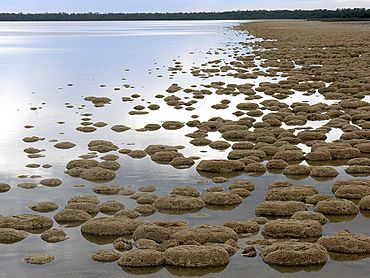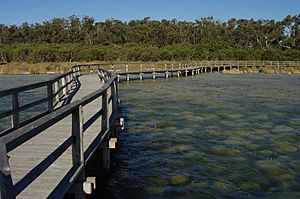Lake Clifton, Western Australia facts for kids
Quick facts for kids Lake CliftonWestern Australia |
|||||||||||||||
|---|---|---|---|---|---|---|---|---|---|---|---|---|---|---|---|

Lake Clifton thrombolites
|
|||||||||||||||
| Established | 1920 | ||||||||||||||
| Postcode(s) | 6215 | ||||||||||||||
| Area | [convert: needs a number] | ||||||||||||||
| Location | |||||||||||||||
| LGA(s) | Shire of Waroona | ||||||||||||||
| State electorate(s) | Murray-Wellington | ||||||||||||||
| Federal Division(s) | Canning | ||||||||||||||
|
|||||||||||||||
Lake Clifton is a small town in the Peel region of Western Australia. It is located on the east side of the lake that shares its name. You can find it just off the Old Coast Road, between the cities of Mandurah and Bunbury. The town is at the northern end of the Yalgorup National Park. In 2021, about 759 people lived in Lake Clifton.
Contents
History of Lake Clifton
Lake Clifton gets its name from Marshall Waller Clifton. He came to Western Australia as a special leader for a land company. He later became a member of the local government, called the Legislative Council.
Early Explorers and Settlers
In 1829, two explorers, Dr Alexander Collie and Lieutenant William Preston, found what are now Lakes Preston and Clifton. They were exploring the coast between Mandurah and Bunbury.
Later, in the 1850s, the "Old Coast Road" south of Mandurah was rebuilt. This happened after people who had committed crimes were sent to the Swan River Colony to work. The road mostly went through sandy, wooded areas not good for farming.
The first European settler in this area was John Fouracre. He built a house here in 1852. By 1854, he had opened an inn and a place for horses to rest along the road.
The Lake Clifton Railway
The town of Lake Clifton began to grow in 1920. This happened because the W A Portland Cement Co. wanted to mine a type of rock called lime there. To help with the mining, a railway line was built to Waroona.
Town Name Changes
The local community group wanted a townsite for the company's workers. The town was first officially named Leschenault in 1921. But this name caused confusion because it was too similar to a place near Bunbury.
So, it was renamed Garbanup. However, the government railways complained again. This name sounded too much like Dardanup. Finally, in 1923, the town was renamed Lake Clifton, which stuck.
Railway Closure
For a short time, Lake Clifton was a busy company town. But the mine closed at the end of 1923. Because of this, the railway was taken apart. Its tracks were moved to Lake Grace to be used for a new railway to Newdegate.
The government officially allowed the railway line to be closed and removed in 1924.
Lake Clifton Today
Today, Lake Clifton has basic places to stay and some shops. There is also a community hall where different activities happen. You can find a couple of places for trucks and cars to stop on Old Coast Road. Some new homes have also been built in areas like Tuart Grove.
Yalgorup National Park
The Yalgorup National Park was created in the 1970s. Its main goal is to protect the lakes, swamps, and special tuart forests in the area. This park is also very important for birds that migrate (travel long distances).
Amazing Thrombolites
At the edge of Lake Clifton, you can see amazing rock-like structures called thrombolites. These are similar to stromatolites. They are built by tiny living things, like very early forms of life on Earth. Scientists think they grow here because fresh groundwater, rich in calcium, comes up from below. A special walkway has been built so visitors can safely view these delicate structures.
In 2011, some French artists started a project to have Lake Clifton listed as a World Heritage Site. This would recognize its special importance to the world.
Transport in Lake Clifton
The main road that goes through the area is the Old Coast Road. This road is part of Highway 1, connecting Mandurah to Bunbury. Buses run by Transwa, which is part of the Public Transport Authority, also stop here. Lake Clifton is also where the Forrest Highway ends.


